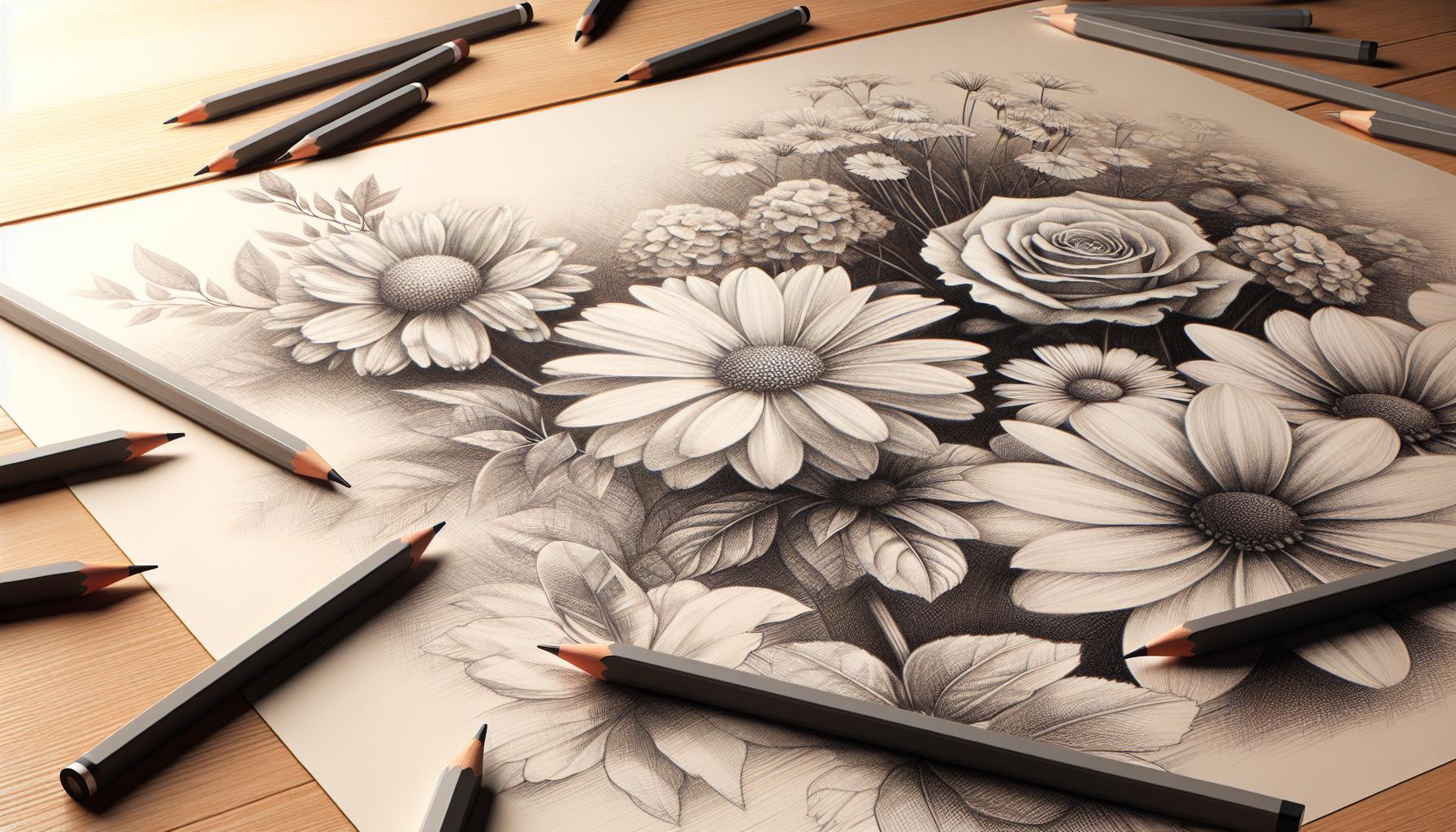Drawing flowers brings joy and tranquility to artists of all skill levels. Whether you’re a beginner seeking simple floral sketches or an experienced artist looking to refine your technique, learning how to draw flowers opens up a world of creative possibilities.
Nature’s most beautiful creations come alive on paper through basic shapes and flowing lines. From daisies to roses these botanical wonders don’t require complex artistic skills to capture their essence. With just a few simple steps and basic supplies anyone can create stunning flower drawings that’ll brighten up any space.
Facil:iiwd7u4dpig= Dibujos De Flores
Drawing flowers starts with understanding fundamental shapes and selecting appropriate materials to create stunning botanical artwork.
Basic Flower Shapes and Forms
Flowers break down into five primary geometric shapes: circles, ovals, triangles, stars and hearts. The center of most flowers features a circular form surrounded by petals radiating outward in symmetrical patterns. Daisies use simple circles with evenly spaced petals, while roses incorporate layered spiral patterns. Tulips follow triangular structures with curved edges, and sunflowers demonstrate Fibonacci spiral patterns in their seed arrangements. Learning these basic shapes enables artists to construct increasingly complex flower drawings:
- Circles form the foundation for daisies, zinnias and black-eyed susans
- Ovals create the base for calla lilies, irises and orchids
- Triangles establish structure for tulips, lilies and morning glories
- Stars shape asters, chrysanthemums and passion flowers
- Hearts define the petals of violets, cyclamen and bleeding hearts
Essential Drawing Materials
The right materials enhance flower drawing capabilities. Basic supplies include:
- Pencils: HB for initial sketches, 2B-6B for shading details
- Paper: Smooth bristol board (98 lb) or drawing paper (70 lb)
- Erasers: Kneaded eraser for lifting highlights, vinyl eraser for clean removal
- Blending tools: Tortillions or blending stumps for smooth gradients
- Fine-point pens: 0.1-0.5mm black markers for crisp outlines
- Colored pencils: 12-24 piece set for adding natural hues
A drawing surface angled at 15-20 degrees provides optimal hand positioning. Natural lighting from the left side (right side for left-handed artists) reduces hand shadows during detailed work. Keeping materials organized in a portable case enables drawing anywhere inspiration strikes.
Step-by-Step Flower Drawing Guide

Creating beautiful flower drawings starts with mastering fundamental techniques. The following steps break down the process into manageable segments for artists of all skill levels.
Starting with Basic Petals
Basic petal shapes form the foundation of flower drawings. Artists begin by sketching light, curved lines to create simple oval or teardrop shapes around a central point. Each petal connects naturally to the flower’s center through smooth, flowing strokes. A daisy requires 8-12 uniform petals arranged in a circular pattern, while a rose incorporates 15-20 overlapping petals that spiral outward. Drawing petals in layers helps establish depth, starting with the innermost petals first. Light pressure on the pencil ensures easy corrections during the initial sketching phase.
Adding Details and Texture
Texture transforms basic petal outlines into lifelike flowers. Artists create depth by adding shadow lines along petal edges using varied pencil pressure. Small curved lines indicate petal veins, while stippling techniques create natural-looking centers in sunflowers or daisies. Cross-hatching patterns add dimension to rose petals, focusing on darker areas where petals overlap. Smudging tools blend graphite to create smooth transitions between light shadow areas. Fine-point pens enhance detailed elements like stamen filaments or tiny leaf serrations after establishing the basic graphite structure.
Popular Flower Types to Draw

Common flowers serve as excellent subjects for artists due to their recognizable shapes and versatile drawing techniques. These classic blooms offer distinct characteristics that make them ideal for both beginners and experienced artists.
Daisies and Sunflowers
Daisies and sunflowers feature circular centers surrounded by uniform petals, making them perfect starting points for flower drawings. The daisy’s simple structure consists of white petals arranged around a yellow center disc, creating an opportunity to practice basic symmetry. Sunflowers showcase a similar pattern with larger dimensions, incorporating a spiral Fibonacci sequence in their seed heads. Artists practice shading techniques through the textured centers of these flowers, while the petals demonstrate principles of foreshortening when drawn at angles.
Roses and Tulips
Roses present complex layers of overlapping petals that spiral from a central point, offering opportunities to master depth and shadow techniques. The rose’s structure starts with a tight center bud that gradually unfolds into fuller outer petals, each with distinct curves and folds. Tulips display elegant simplicity with their cup-shaped blooms, featuring six petals that form a symmetrical pattern. Their smooth contours allow artists to explore gradual shading transitions while their stems demonstrate graceful curved lines. Both flowers excel at teaching perspective through various growth stages from bud to full bloom.
Shading and Coloring Methods

Effective shading and coloring transform flat flower drawings into vibrant, three-dimensional artwork. These techniques bring life to petals through the strategic use of light, shadow and color variations.
Creating Depth and Dimension
Artists create depth in flower drawings through layered shading techniques that emphasize light sources and cast shadows. Gradient shading establishes form by transitioning from light to dark areas on petals, starting with the lightest values near the light source. Cross-hatching adds texture through intersecting lines at 45-degree angles, while circular strokes create soft transitions in rounded areas like flower centers.
Key shading methods include:
- Hatching patterns parallel to petal curves
- Stippling for delicate texture transitions
- Blending from dark outer edges to light centers
- Casting shadows between overlapping petals
- Adding reflected light on petal undersides
Dimensional effects emerge through:
- Value contrast between adjacent petals
- Shadow mapping on concave surfaces
- Highlight placement on convex areas
- Edge definition with varying line weights
- Atmospheric perspective in flower clusters
- Petal thickness variations
- Surface texture details
- Depth between flower layers
- Form transitions in curved areas
- Spatial relationships within the composition
Tips for Achieving Natural-Looking Results
Creating realistic flower drawings requires attention to specific details that bring artwork to life. Light sources determine shadow placement on petals creating dimensional effects. Artists enhance realism by varying line thickness along petal edges.
- Observe Light Patterns
- Study how light falls across real flowers
- Mark highlights on the uppermost petals
- Place darker values in overlapping areas
- Add cast shadows beneath flowers
- Create Texture Details
- Draw small lines to indicate petal veins
- Add stippling for natural surface variations
- Include subtle wrinkles near petal bases
- Depict dewdrops using highlight spots
- Master Petal Transitions
- Blend colors gradually between shades
- Layer pencil strokes in petal direction
- Soften edges where petals overlap
- Define crisp edges for damaged areas
- Incorporate Natural Elements
- Draw leaves with organic imperfections
- Include stems with slight curves
- Show growth variations in petal sizes
- Add environmental elements like buds
Proportion accuracy enhances drawing authenticity. Studying real flowers provides reference for size relationships between elements. Drawing multiple flowers at different angles demonstrates natural growth patterns. Environmental context like scattered petals adds realism.
| Element | Purpose | Technique |
|---|---|---|
| Line Weight | Depth perception | Vary pressure |
| Texture | Surface detail | Directional strokes |
| Shadows | Dimension | Gradual blending |
| Highlights | Focus points | Reserved white space |
Combining these techniques creates drawings that capture flowers’ organic qualities. Using reference photos guides proper light placement. Regular practice develops muscle memory for natural mark making.
Drawing flowers offers a rewarding journey into artistic expression that anyone can explore. Through basic shapes combined with proper techniques and materials artists can create stunning floral artwork that captures nature’s beauty. The journey from simple geometric forms to detailed renditions becomes achievable with practice and patience.
By mastering shading incorporating texture and understanding light patterns artists develop skills that bring their flower drawings to life. Whether starting with easy daisies or advancing to complex roses each flower presents unique learning opportunities. The art of drawing flowers not only enhances creative abilities but also provides a peaceful and fulfilling artistic pursuit.



